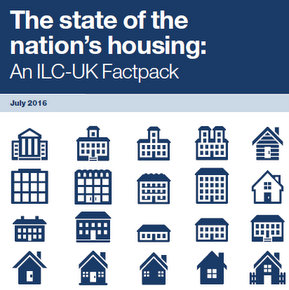
ILC-UK reports on poor state of UK housing for older people
Howard Chapman reviews the latest ILC-UK report on the poor state of housing for older people in the UK. The retirement housing supply is set to worsen, but solving older people’s needs could free-up under-occupied housing.
The International Longevity Centre – UK (ILC-UK) is a think-tank impacting policy on longevity, ageing and population change.
Its recent Factpack reveals that the retirement housing supply gap is set to worsen. Despite significant increases in the numbers of older people living alone – 9 in 10 of the 65-79 age group now reside in under-occupied housing – half of all elderly people with care needs haven’t made the necessary adaptations to their homes.

Source: expertfile
Population ageing has resulted in rising care needs, which are not being met. According to the report, there are half a million fewer people receiving care services than there were in 2008-9.
‘There are millions of over 50s with care needs who haven’t adapted their housing for old age and may be in homes too big for them,’ says Baroness Sally Greengross, Chief Executive of ILC-UK. ‘If older people are to live longer in their own homes, the government must ensure that planning supports and encourages adaptations.’
The report suggests that addressing the issues of older people and housing could free-up under-occupied housing, which would benefit the next generation and youger people looking to buy houses.
Getting serious about housing supply
However, whilst specialist retirement housing could be a solution for some, the report projects a shortage of 160,000 retirement housing by 2030. By 2050, the gap could grow to 376,000.
Britain’s current level of housebuilding does not meet the housing needs of our growing population. A renewed housebuilding effort must focus on the needs of the older population and plug the retirement housing supply gap. Research has shown that investing in the housing needs of older people, who often have assets at their disposal, can be a cost effective way of freeing up the housing chain for younger people.
Baroness Greengross suggests that a freeze in the current rate of stamp duty might encourage more over 50s to move to homes better suited to their current and future needs.
Adapting to changing needs
Over the long term, an older population will require a more mature retirement housing market which offers real options for older people. Currently, traditional retirement housing makes up the majority of housing specifically provided for older people, with the majority (75%) built and owned by local authorities and housing associations.
These provide an important function, and, as this report has shown, the vast majority of people living in them are far more likely to live in homes with adaptations than those who don’t. But many of these were built decades ago.
New, purpose built stock, is required – some of which with a provision for care support. This is starting to happen but not nearly quickly enough.
One comment on “ILC-UK reports on poor state of UK housing for older people”
Leave a Reply
You must be logged in to post a comment.
Latest news

29th April 2025
Senior pledges to ‘bee’ part of the solution with new biodiversity initiative
Senior Architectural Systems has installed its first on-site beehive, marking another step forward in its commitment to sustainability and biodiversity.
Posted in Articles, Building Industry News, Building Products & Structures, Building Services, Curtain Walling, Doors, Glass, Glazing, Innovations & New Products, news, Restoration & Refurbishment, Retrofit & Renovation, Sustainability & Energy Efficiency, Walls, Windows
29th April 2025
West Fraser range delivering key benefits for South-East carpentry company
An experienced carpenter and building site manager who has recently set up his own company is using high performance panel products from the West Fraser range.
Posted in Articles, Building Industry News, Building Products & Structures, Building Systems, Case Studies, Garden, Restoration & Refurbishment, Retrofit & Renovation, Sustainability & Energy Efficiency, Timber Buildings and Timber Products
29th April 2025
CPD Courses Available Online From Ecological Building Systems
Ecological Building Systems, a leading supplier of natural building products for sustainable construction, has revealed its comprehensive CPD programme for the year ahead.
Posted in Articles, Building Industry Events, Building Industry News, Building Products & Structures, Building Services, Continuing Professional Development (CPD's), Information Technology, Innovations & New Products, Insulation, Restoration & Refurbishment, Retrofit & Renovation, Seminars, Sustainability & Energy Efficiency, Training, Walls, Waste Management & Recycling
29th April 2025
WindowBASE launches new prospect databases at FIT Show
Visit WindowBASE at the FIT Show to see first-hand how it helps companies find new customers – the company is launching an easy-to-use, intuitive platform on Stand G16 at the NEC Birmingham from 29th April – 1st May.
Posted in Articles, Building Industry Events, Building Industry News, Building Products & Structures, Building Services, Doors, Exhibitions and Conferences, Glass, Glazing, Information Technology, Innovations & New Products, Posts, Publications, Research & Materials Testing, Restoration & Refurbishment, Retrofit & Renovation, Windows

Much of what is out there is totally unsuitable for couples one of which uses an electric wheelchair, even when built to building reg M standard, rooms are too small. read our story at http://onmybiketoo.blogspot.co.uk there is also a lack of understanding built in regarding extra hygiene needs of those with LTC’s , many only have one bathroom which means careworkers / non family members using the same bathroom washing facilities as the person they care for a receipe for disaster. Downsizing for wheelchair users is a misnomer, rightsizing is more appropriate.